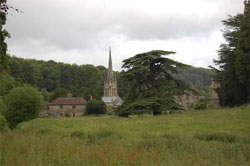Settlement in the Landscape
 From grand houses, Medieval halls and churches to historic farmsteads and estate cottages, the distinctive style of the built environment is an intrinsic part of what makes this living landscape special.
From grand houses, Medieval halls and churches to historic farmsteads and estate cottages, the distinctive style of the built environment is an intrinsic part of what makes this living landscape special.
The AONB has a rich vernacular architecture using local building materials including flint, brick, greensand, Tisbury and Chilmark stone, timber-framing, etc and local thatching and roofing styles.
Diverse range of settlement plans including nucleated villages, linear, irregular, dispersed and on the edge of common land with distinct geographical distributions.
Later Prehistoric settlement are often at the centre of extensive field systems and there are clusters of Romano-British settlement along the West Wiltshire Downs, though the wooded downland of the Cranborne Chase and in the vicinity of Badbury Rings. Scattered evidence for higher status buildings including at least two Roman Villas.
Anglo-Saxon charters suggest that many of the modern settlements within the AONB have Early Medieval origin, and there are a large number of shrunken and deserted Medieval Villages. Manor houses and Medieval halls representing the original 'Demense' often occur at the core of the original village and the majority of settlements have a surviving Medieval plan at their core. There are several planned Medieval villages, including Hindon and Steeple Langford. Large churches are found at the centre of the villages often having a Medieval building fabric.
Overarching influence of 'estate' style in some places. This varies in scale from isolated buildings, groups of cottages at the edge of settlements and entire villages.
Large historic country houses of several main phases associated with a wide range of ancillary buildings are also a common feature. THese often have a complex history of development and rebuilding. These are often separate from the main settlement.
There are large complexes of farm buildings located both in isolated positions and on the edge of settlements.
More information on the historic settlement of the AONB can be accessed by clicking here: Theme 11: Settlement in the Landscape.
This document forms part of the wider AONB Historic Environment Action Plans.
